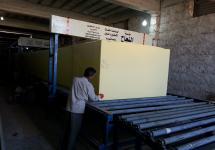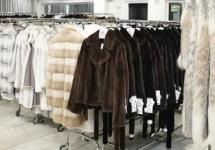Updated: 16.02.2018 10:12:02
Ironing boards make ironing easier and reduce the time it takes to iron clothes. But that's not all they can do. Some models can be transformed into ladders, built into pieces of furniture or turned into clothes dryers. Today we will tell you what are the advantages and disadvantages of each type of ironing board and what you need to pay attention to when buying.
Types of ironing boards

This is one of the most popular types of boards. They fold easily and can often adjust to a person's height. Many of them are equipped with an armrest, an iron stand, a socket and a cable holder.
Some portable boards can transform into ladders or clothes dryers and vice versa. This is a good option for small spaces.
Advantages
Excellent stability;
You can adjust the height (usually 30 cm);
Ironing clothes can be done in any convenient place;
Some folding boards have additional features. They can heat the ironing surface, remove excess steam, blow, which allows you to iron delicate materials and small parts of clothing.
The board can be folded and hidden behind a closet, door or sofa;
The table top is long and wide enough to iron large clothes and linens. As a rule, the length of the product varies from 120 to 125 cm, and the width - from 38 to 46 cm. There are also models that are about 140 cm long and 46 cm wide.
A large selection of models, ranging from the simplest products, consisting only of countertops and legs, and ending with clothes dryer boards;
Flaws
Take up a lot of space when unfolded;
You need to find a place where the board will be stored.

Desktop models are installed on a flat surface, most often on a table. They are quite compact - the working surface is about 70–85 cm long and 30–35 cm high, they are light (1.5–3 kg) and have small non-slip feet. Such models are ideal for ironing underwear, small clothes, children's clothes. In addition, they are convenient to store - many boards can be hung from the wall with a hook.
Advantages
Affordable price (from 350 rubles);
Good stability;
Light weight - easy to transport;
Convenient to store;
Take up little space;
Flaws
Not suitable for ironing large items;
They do not have such additional features as a stand for an iron or steam generator, a cable holder, a built-in socket and

These models are most often built into full-size wall mirrors, but sometimes they “hide” behind magnetic whiteboards (for children) or glass photo panels. To unfold the board, you need to move the facade to the side.
Coupe models are often equipped with an iron socket and have the same work surface dimensions as regular floor boards.
Advantages
It is convenient to iron clothes of large sizes and curtains on them;
Designed for heavy weight (from 20 to 50 kg);
Easy to fold and unfold;
Flaws
High price (15,000–20,000 rubles);
Cheap coupe boards are characterized by flimsy construction and, therefore, low strength. In addition, the transformation mechanism may become loose;
Cannot be transferred to another room;

Retractable boards are a great option for small apartments and for those who want to save more space. They can be installed together with a dryer and washing machine, as well as built into the drawers of cabinets or furniture walls.
Advantages
Space saving;
Suitable for quick ironing;
Simple retractable system;
Flaws
The sliding mechanism may break;
The maximum load on such boards is about 10–15 kg;
The ironing surface is small;
High price (15,000–30,000 rubles)

Transformer boards look like a chest of drawers with several drawers / laundry baskets, the surface of which unfolds. The tabletop has standard dimensions (about 120-130 cm long and 35 cm wide) and is often equipped with an iron stand. The body of the cabinet can have four wheels with a locking mechanism, which increases the mobility of the product.
Advantages
Excellent stability;
Good price, as for a 2 in 1 thing (5,000–9,000 rubles);
You can not lay out the board to iron small items and children's clothes;
Multifunctionality - storage of things and ironing clothes;
Flaws
Low mobility;
The height cannot be adjusted.
Choosing the material of the countertop for the ironing board and its size
The strength and durability of the ironing board depends on the material of the tabletop, and the ease of use depends on the size. As a rule, it is made of thermoplastic, aluminum, steel or wood.
Thermoplastic is one of the most successful options for the production of ironing boards. This is a lightweight material, so an ironing board with such a table top weighs a little (4–5 kg). Thermoplastic surfaces have excellent resistance to high temperatures, steam and moisture and have a long service life.
Wooden countertops are made from plywood or chipboard. This is the most budget option - folding wooden ironing boards cost about 500–1,500 rubles. However, wooden surfaces are not very durable - over time they swell, delaminate and become unusable.
Metal countertops are made from aluminum or steel. Aluminum models are resistant to corrosion and are light in weight, but they are prone to deformation - they bend and scratch easily. Steel products weigh more, but they are characterized by high strength and durability.
Metal countertops can be either solid metal sheet with holes or metal mesh. Mesh surfaces wick away excess steam well, but may leave perforation marks on clothing. This is a good option for steam processing things. All-metal products are more durable, but with a small number of holes, they pass steam less and have more weight than mesh countertops.
Ironing board dimensions
The ironing board tabletop sizes range from 30 cm to 46 cm wide and from 70 cm to 150 cm long. Small products are suitable for small spaces and temporary housing, as well as for quick ironing and small items of clothing.
Models of large sizes should be chosen if you have to iron a large amount of bed linen, towels and curtains. Of course, if you do not need to iron the “mountains” of bed linen every day, you can also buy an ordinary ironing board with a surface of 110-120 cm in length and 30-38 cm in width.
Deciding on an ironing board cover
Ironing board covers are made from cotton and synthetic materials. Cotton is easy to wash and breathable, but if cheap dyes were used to dye it, it can shed. Therefore, it is better to choose ironing boards with light covers without patterns. In addition, cheap cotton covers do not "live" for a long time.
Polyester is often used in the production of budget ironing boards. Polyester covers often stick to the iron and build up static electricity. Their service life is 1-1.5 years.
The best materials for covers are fabrics with a metallic thread. They have non-stick properties, reflect steam and heat well, which ensures double-sided ironing of clothes. Often such products have a Teflon coating, which increases their durability and strength.
When buying, you should also pay attention to the type of fixation of the cover. It can be attached to the tabletop with elastic bands, ribbons, Velcro and cords. Covers with elastic bands are considered the most unreliable, because. over time, elastic bands stretch, and with cords - the most durable.
It is also important that the case has a soft lining (at least 2mm thick). It facilitates the ironing process and protects from the marks left by the metal mesh of the countertop on clothes.
Linings for a cover are made from batting, foam rubber and synthetic winterizer. Batting is not recommended for boards made of chipboard and plywood, because. it has high moisture permeability, and therefore contributes to the deformation of the wooden surface.
Stability and supports
When buying, pay attention to the width of the legs and the method of fastening. If the legs of the ironing board are not widely spaced, the stability of the product will be poor. The best option is when the bases of the legs are wider than the table top.
If the legs are attached to the table top and to each other with bolts and rivets, they can loosen over time. Rivets are considered the most unreliable method of fixing.
To prevent the board from slipping and scratching the floor, choose products with silicone or rubber caps on the legs.
When buying, pay attention to the shape of the legs. T-shaped structures are considered the most stable.
Locking mechanisms - ironing board height
The height of many boards can "adjust" to the height of the owner. In most cases, the tabletop can be raised by 20–30 cm (up to 94–98 cm).
Ironing boards can have step and smooth height adjustment. Step adjustment allows you to raise the tabletop by 2-3 levels, and with the help of smooth adjustment you can set the ironing surface at any height. However, over time, the reliability of fixing models with smooth height adjustment is lost, and the structure becomes loose.
We select the weight of the ironing board, iron stand and drawers for storing linen

When buying, be sure to pay attention to the weight of the ironing board. The lighter the product, the easier it will be to carry and lay out. Ideally, this should be a board weighing 4–7 kg.
To make the product weigh less, manufacturers use perforated metal sheets, plywood sheets or thin chipboard. However, be careful - too thin wooden countertops will quickly become unusable, and thin metal mesh boards will deform.
When buying, pay attention to the iron stand. The new Euro coasters, on which the iron can be placed in two positions, are not suitable for all irons. In addition, users note that in steam mode and at an angle, condensation collects and drips onto the floor. Classic horizontal stands are suitable for any size of iron.
Some folding ironing boards are equipped with drawers or laundry baskets. Laundry that has just been ironed can be folded into them, saving the time required for ironing.
In addition, ironing boards are often equipped with accessories and features such as:
Underarm;
Built-in socket and extension cord;
Wire holder - prevents the cable from catching on the countertop or clothes;
Pressurization - protects delicate fabrics (for example, velor) from damage;
Heating - things are ironed on both sides;
Vacuum - the fabric "sticks" to the work surface, does not slip and does not wrinkle under the iron. This facilitates the ironing process and allows you to make perfect folds or arrows on clothes.


